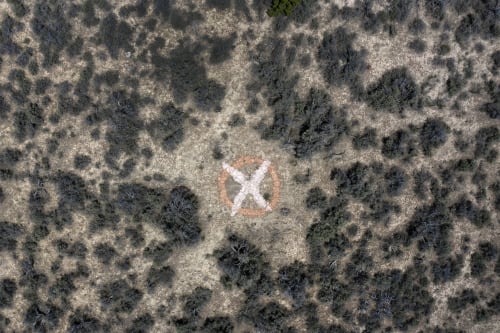Four years ago, the artist Brie Ruais took a solitary road trip through America’s deserts, looking for a home that would provide her with the open space and connection to nature that she was missing in Brooklyn, where she has a studio. She bought a piece of land in the Great Basin Desert of Nevada and began making land art there. Often naked, and sunburned, she used her body to trace the marks left on the flat, dry land by animals that traverse it, but also industries such as mining and trucking. “It’s horrific to see an open pit mine, or a clear cut forest,” she says. “These are things that are intentionally hidden from sight.”
The only witness to her tracing was an aerial drone, which captured footage as she moved her body across the scars in the land. “As a queer white woman in the world, I have a discomfort taking up space,” she says. “Within these works, there was a revealing of my mark, my presence, my occupation.” Bold and created in all the glorious beauty of female flesh, Ruais’ interventions seem to be a marked middle finger to the macho history of Land Art in America, which is primarily made by men.
The aerial footage was the starting point for “Spiraling Open and Closed Like an Aperture,” a body of Ruais work currently on view at Night Gallery in Los Angeles through January 23, 2021. The exhibition includes photographs culled from the site-specific interventions Ruais made with her body, as well as a number of ceramic sculptures made in her studio in Brooklyn, all of them in direct dialogue with her ephemeral works made in Nevada.
In the title for her show, Ruais specifically references how we, as a society, turn a blind eye towards the continuing destruction of nature, especially in the deserts. In a metaphorical way, she sees her work as shedding light on what is going on — the poisoning of habitats due to the chemicals used in mining, the loss of rivers due to over-irrigation, the gaping holes dug into the flat land. “I am opening up information,” she says.
The clay sculptures are made on the floor, and specifically reference Ruais’s body weight, which she uses to measure the amount of clay she’ll use in the work. Resembling clocks, or sunbursts, the sculptures often incorporate rocks or materials from the desert sites where Ruais has traveled or worked. Made on the floor, they are hung on the walls — Ruais says that in hanging them, the sculptures become like maps of her process. Painted in earth tones with flashes of turquoise and yellow, the sculptures are decidedly talismanic, seeming to reference ancient calendar stones that told stories of the heavens in the language of deities.
A large floor piece dominates the center of the gallery. Entitled The things we build, the things we let fall apart, the things we destroy (2020), the work was during the election season. Consisting of two sunbursts of clay, one white and one burnt sienna, that are bisected by a stone wall consisting of stones that Ruais collected on her car trip from Nevada to Los Angeles, Ruais says that the work reflects how she felt about the political landscape leading up to November. “We are so aligned, we have such similar interests,” she says. “But we cannot see one another.” Similarly, the two clay sunbursts, laid out on the floor, are obscured by the rock wall. “It’s interesting to me that these stories are embedded in our geology,” Ruais says.
To learn more about the exhibition, visit Night Gallery’s website.

